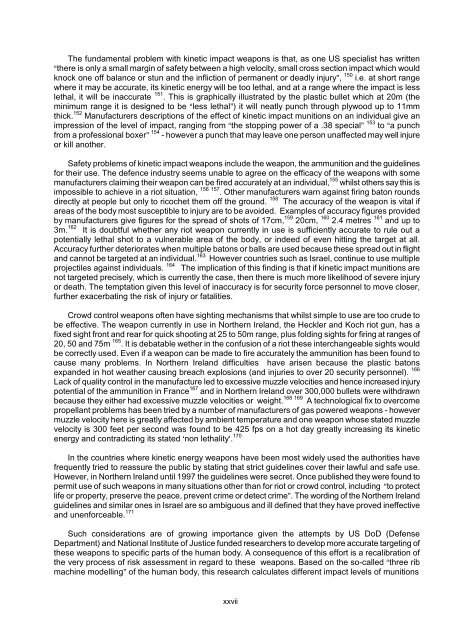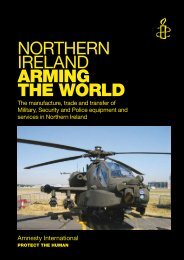CROWD CONTROL TECHNOLOGIES - Omega Research Foundation
CROWD CONTROL TECHNOLOGIES - Omega Research Foundation
CROWD CONTROL TECHNOLOGIES - Omega Research Foundation
You also want an ePaper? Increase the reach of your titles
YUMPU automatically turns print PDFs into web optimized ePapers that Google loves.
The fundamental problem with kinetic impact weapons is that, as one US specialist has written<br />
)there is only a small margin of safety between a high velocity, small cross section impact which would<br />
knock one off balance or stun and the infliction of permanent or deadly injury(, 150 i.e. at short range<br />
where it may be accurate, its kinetic energy will be too lethal, and at a range where the impact is less<br />
lethal, it will be inaccurate 151 . This is graphically illustrated by the plastic bullet which at 20m (the<br />
minimum range it is designed to be )less lethal() it will neatly punch through plywood up to 11mm<br />
thick. 152 Manufacturers descriptions of the effect of kinetic impact munitions on an individual give an<br />
impression of the level of impact, ranging from )the stopping power of a .38 special( 153 to )a punch<br />
from a professional boxer( 154 - however a punch that may leave one person unaffected may well injure<br />
or kill another.<br />
Safety problems of kinetic impact weapons include the weapon, the ammunition and the guidelines<br />
for their use. The defence industry seems unable to agree on the efficacy of the weapons with some<br />
manufacturers claiming their weapon can be fired accurately at an individual, 155 whilst others say this is<br />
impossible to achieve in a riot situation, 156 157 . Other manufacturers warn against firing baton rounds<br />
directly at people but only to ricochet them off the ground. 158 The accuracy of the weapon is vital if<br />
areas of the body most susceptible to injury are to be avoided. Examples of accuracy figures provided<br />
by manufacturers give figures for the spread of shots of 17cm, 159 20cm, 160 2.4 metres 161 and up to<br />
3m. 162 It is doubtful whether any riot weapon currently in use is sufficiently accurate to rule out a<br />
potentially lethal shot to a vulnerable area of the body, or indeed of even hitting the target at all.<br />
Accuracy further deteriorates when multiple batons or balls are used because these spread out in flight<br />
and cannot be targeted at an individual. 163 However countries such as Israel, continue to use multiple<br />
projectiles against individuals. 164 The implication of this finding is that if kinetic impact munitions are<br />
not targeted precisely, which is currently the case, then there is much more likelihood of severe injury<br />
or death. The temptation given this level of inaccuracy is for security force personnel to move closer,<br />
further exacerbating the risk of injury or fatalities.<br />
Crowd control weapons often have sighting mechanisms that whilst simple to use are too crude to<br />
be effective. The weapon currently in use in Northern Ireland, the Heckler and Koch riot gun, has a<br />
fixed sight front and rear for quick shooting at 25 to 50m range, plus folding sights for firing at ranges of<br />
20, 50 and 75m 165 . It is debatable wether in the confusion of a riot these interchangeable sights would<br />
be correctly used. Even if a weapon can be made to fire accurately the ammunition has been found to<br />
cause many problems. In Northern Ireland difficulties have arisen because the plastic batons<br />
expanded in hot weather causing breach explosions (and injuries to over 20 security personnel). 166<br />
Lack of quality control in the manufacture led to excessive muzzle velocities and hence increased injury<br />
potential of the ammunition in France 167 and in Northern Ireland over 300,000 bullets were withdrawn<br />
because they either had excessive muzzle velocities or weight. 168 169 A technological fix to overcome<br />
propellant problems has been tried by a number of manufacturers of gas powered weapons - however<br />
muzzle velocity here is greatly affected by ambient temperature and one weapon whose stated muzzle<br />
velocity is 300 feet per second was found to be 425 fps on a hot day greatly increasing its kinetic<br />
energy and contradicting its stated non lethality. 170<br />
In the countries where kinetic energy weapons have been most widely used the authorities have<br />
frequently tried to reassure the public by stating that strict guidelines cover their lawful and safe use.<br />
However, in Northern Ireland until 1997 the guidelines were secret. Once published they were found to<br />
permit use of such weapons in many situations other than for riot or crowd control, including )to protect<br />
life or property, preserve the peace, prevent crime or detect crime(. The wording of the Northern Ireland<br />
guidelines and similar ones in Israel are so ambiguous and ill defined that they have proved ineffective<br />
and unenforceable. 171<br />
Such considerations are of growing importance given the attempts by US DoD (Defense<br />
Department) and National Institute of Justice funded researchers to develop more accurate targeting of<br />
these weapons to specific parts of the human body. A consequence of this effort is a recalibration of<br />
the very process of risk assessment in regard to these weapons. Based on the so-called )three rib<br />
machine modelling( of the human body, this research calculates different impact levels of munitions<br />
xxvii




